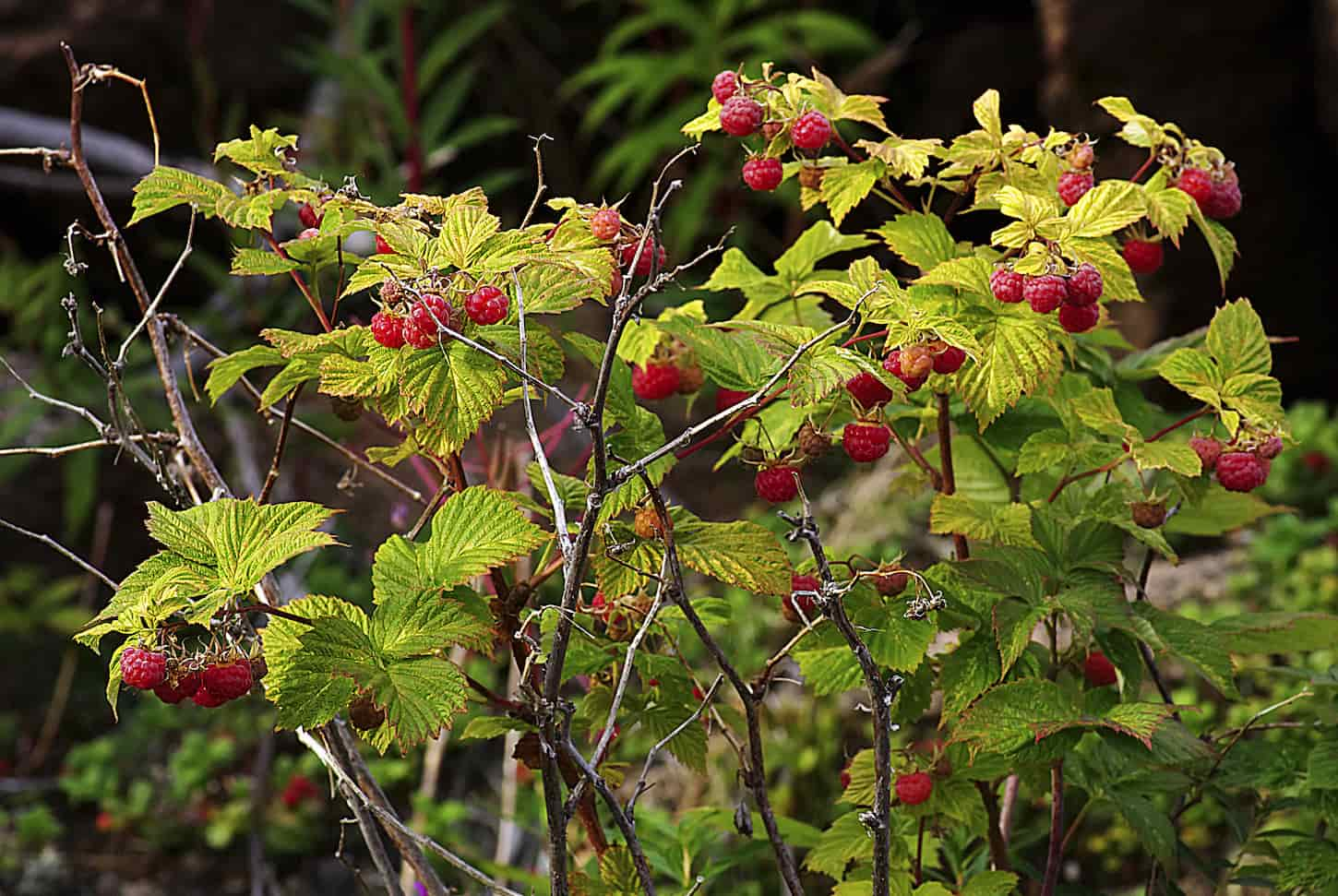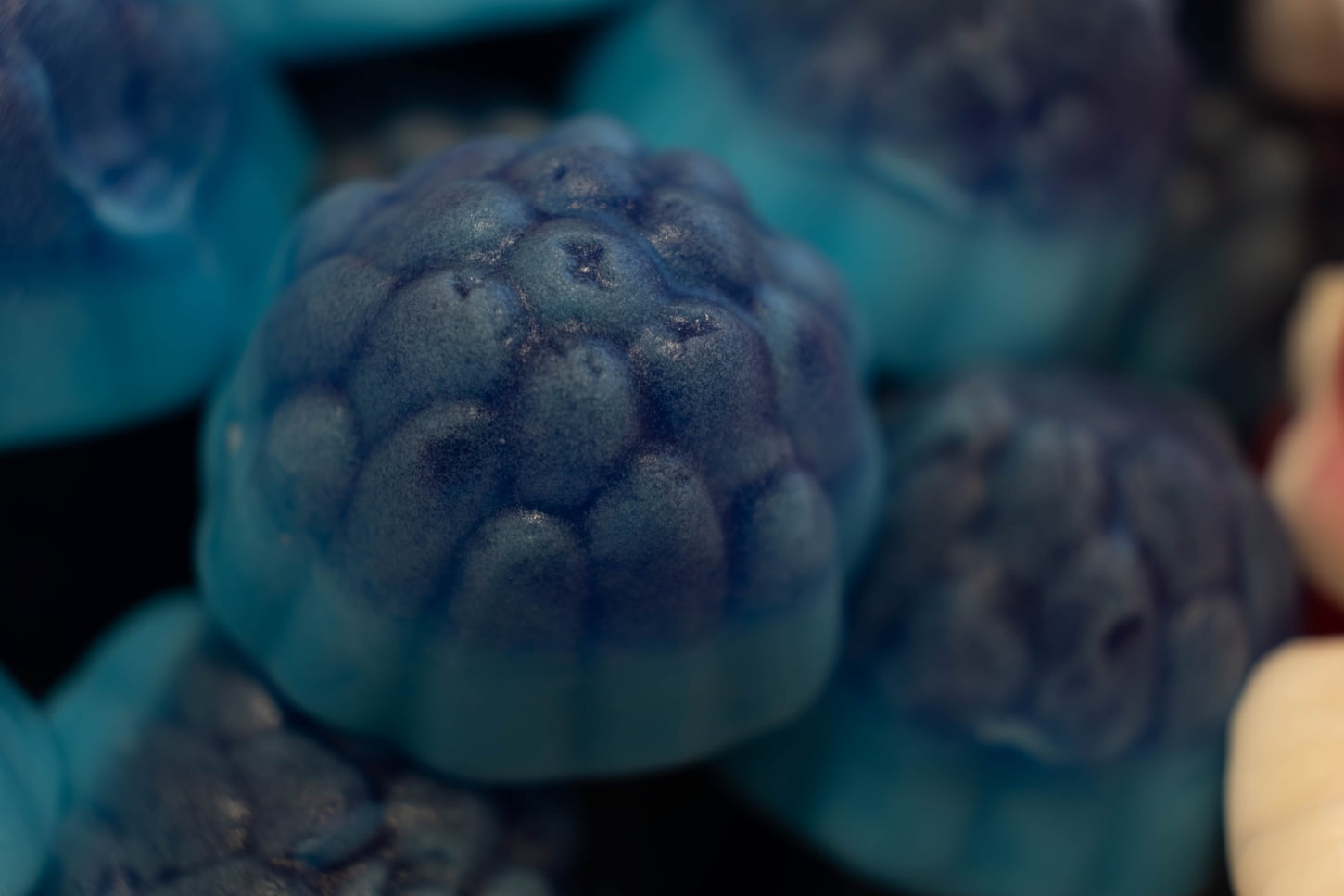We’re familiar with raspberries: sweet, tart, and red. But what about the blue raspberry? While they exist mostly in artificially flavored products such as candy and drinks, the fruit is also found in nature.
Blue raspberries are native to western North America. It’s also known as the whitebark raspberry, and it can be found in Alaska, California, Arizona, New Mexico, and Chihuahua (Mexico). While they can be grown naturally, their flavor can be replicated in laboratories to use in food and beverages.
Are you curious to know more about this interesting fruit? In this article, you’ll find all there is to know about the blue raspberry fruit, including how to grow one. In addition to that, the origins of the popular blue raspberry flavor will also be uncovered.

What Is a Blue Raspberry?
Blue raspberries, which look just like a regular raspberry, are scientifically classified as “rubus leucodermis.” Blue raspberries look exactly like their red-berried counterpart, but they are reddish-purple and will turn dark purple (or nearly black) when ripe.
They’re circular or oval, consisting of around 100 individual smaller pieces to make up one berry or fruit.
Instead of the bright red and pinkish hue that raspberries have, blue raspberries turn red to reddish-purple. They then turn dark purple to nearly black when ripe. When it comes to their flavor, blue raspberries resemble red or black raspberries.
Are Blue Raspberries Real?
While blue raspberries are real, many photos of blue raspberries online are often enhanced, depicting a bright blue color. They are much darker in reality, like the color of blackberries.
Blue raspberries – the thought of it sounds almost fake, but they do exist in nature. However, they may not be as you imagine them to be. Thanks to the overexposed marketing of blue raspberry-flavored products, it’s natural to think the fruit itself is of the same intense hue.
Is There a Blue Raspberry in Nature?
Blue raspberries exist in nature and can be found in zones 5-9. They grow on second-year canes (floricanes).
Blue raspberry branches bear fruits after two years, like summer-bearing red raspberries. They grow in temperate and subtropical climates. Specifically, blue raspberries have plant hardiness in zone 5-9, but can be in zone 10a with proper care.
For those unsure about plant hardiness, it’s an indicator that labels plants as being suitable for a particular area (source). It’s usually defined by temperatures, particularly the minimum and maximum temperature a plant can withstand.
Interestingly, their leaves are also edible and are often used for medical purposes. Then again, leaves from red raspberry plants can also be eaten – and are often used to make teas or various herbal medicines.
It’s also clear, just by looking at the freezer section of a grocery store, that there are plenty of blue raspberry snacks on the market.
Are Foods with a Blue Raspberry Flavor Natural?
Many foods and beverage companies also utilize and market their products with blue raspberry flavors. However, this is mostly fake coloring and flavors. In fact, the blue raspberry flavor mimics the flavor of the fruit by using less expensive juices, like apple or orange (source).
But do these products contain natural blue raspberries?
Sometimes, blue raspberry-flavored products claiming to contain natural flavors don’t have any blue raspberry flavor. As blue raspberries are not as commonly grown as other fruits, they can be costly to use in products.
That’s why they use apple or orange flavors combined with other natural flavors to mimic the deliciousness that is blue raspberry.

Blue Raspberries: A Cultural Phenomenon?
When selling products, eye-catching color is key to getting the goods off the shelves and into the shopping cart. This is why it’s no surprise to find an enticing color, like electric blue, on both the packaging and the product.
When the product matches your taste, it can play up with your senses. You’ll find blue raspberry-flavored candy, sports drinks, and even alcohol.
Many foods and beverage companies also utilize and market their products with blue raspberry flavors. However, this is mostly fake coloring and flavors.
The market for “red” flavors is often described as over-saturated. Red flavors often include cherry, watermelon, strawberry, red apple, and more. Instead, raspberry was made blue, as there are hardly any natural blue foods.
Except for blueberries, there was no other fruit in nature that could claim a blue shade. Drawing attention to raspberry and the “creation” of blue raspberry started all the way back in the mid-20th century.
Food coloring was gaining traction in the 50s, making candy more delectable to younger consumers due to color intensity. The dark red dye used in “red-flavored” products (FD&C Red No. 2) was found to be a possible carcinogen. When it was banned, food developers found a way around it and used the Brilliant Blue dye (FD&C Blue No. 1) instead (source).
Thanks to treats such as ICEEs and Otter Pops, the blue raspberry flavor turned into a movement in the 70s. Ever since it has continued to appeal to young children because of its vivid color.
After the success of bright red coloring, blue would only be the appropriate successor. It just needed some fruit to take after and raspberry was the top contender. Now, it’s often hard to tell apart the difference between blue and the standard blue raspberry.
In terms of taste, it’s more a mix of apple, orange, pineapple, and banana than raspberry in an artificially raspberry-flavored product.
Can You Grow Blue Raspberries?
Blue raspberry plants can be grown outdoors in zones 5 to 9. The easiest way to start growing one is to purchase an existing plant from a local nursery. However, it can also start growing through vegetative reproduction or from a bare root.
Alternatively, you can also plant it from a seed. The blue raspberry plant seed will have a germination time of around two to eight weeks. While there are plenty of ways for it to grow, it’s recommended that you plant it in either winter, spring, or summer.
You can also grow blue raspberries in other zones, as long as you’re able to adjust for any temperature extremes. For example, you could grow a blue raspberry in colder climates by keeping it in a greenhouse.

What You Need to Grow Your Own Blue Raspberry Plant
To grow a blue raspberry plant, you’ll need slightly acidic and moist soil rich with organic matter and mulch. Adding fertilizer in the early spring – the beginning of the fruit’s harvesting season – will encourage growth.
Blue raspberry plants require an average amount of water to survive. It’s vital that the water doesn’t sit on the soil. Instead, it will need a proper drainage channel to efficiently disperse the water throughout the soil and roots.
It’s best to grow them in a temperate climate, and nothing drastic or above 104 degrees Fahrenheit. In terms of light conditions, it requires full sun to partial shade. Too much sun during the summer can damage the plant and sunburn the fruit.
To control sun exposure, consider placing a shading net over the berry plant, or growing it under a tree.
In its early stages, it’s recommended to support the plant with a trellis. You may also want to top the canes if they’re too unwieldy.
Caring For Your Blue Raspberry Plant
The fruit’s harvesting season goes from spring all the way through to autumn. Make sure to keep pests away from the plant, particularly birds, as they like to eat the fruit. Other pests include mites, aphids, and cane borers.
When it comes to pruning, it’s best to do it once a year after harvesting the fruits. Generally, wintertime is the best pruning season, as it paves way for the beginning of spring. After bearing the fruit, old branches should be pruned, leaving around two to four inches from the ground. Its leaves are also edible and have medicinal purposes as well when used correctly.
Want to read more about pruning raspberry bushes? Make sure you check out our complete guide to pruning berry bushes here: Pruning Berries: The Ultimate Guide.
When taken care of and given the right needs, blue raspberry plants are fast-growing. As it needs plenty of sun and water, it’s not an ideal indoor houseplant and should be kept outside. When fully grown, blue raspberry shrubs can reach up to 8 feet in height.
Once the fruit is harvested, it can be enjoyed in several ways. You can eat it raw, bake it into a cake, juice them or dry them out. As the fruit can be harvested in spring, summer, and autumn, it makes for a very high-yielding plant. Blue raspberries can be enjoyed throughout most of the year.

Final Thoughts
Despite having seen plenty of blue raspberry drinks or candy on supermarket shelves, it’s not a fruit we commonly see. In fact, the blue raspberry is a wild berry that most of us have probably never seen or tasted. I certainly didn’t realize it was a natural-growing plant, and it can grow here!
If we did ever see it, we may have mistaken it for a blackberry. I’ve seen lots of blackberries – and have seen black raspberries. But I haven’t seen a blue raspberry – that I know of. It doesn’t stop me from wanting to add one to my garden, though, now that I know about it!
Although many products depict blue raspberries with a bright blue hue, the real fruit isn’t as vibrant in color. It has a darker shade of blue, but sometimes it can also be purple or even black.
Blue raspberries are perfectly capable of growing naturally. It’s not just created in a lab for its artificial flavor to be used in food and beverages. Like their red counterparts, blue raspberries grow in shrubs and can be harvested for various uses.
The blue raspberry plant’s hardiness zone ranges from 5 to 9, which means it’s quite a resilient plant. It can withstand a wider range of temperatures. For those living in a temperate climate, consider adding a blue raspberry bush to your garden for some diversity.
Ready to read more about raspberries (of any color or variety)? Make sure you read this guide to moving raspberry plants article I wrote next. That way, you’ll be ready to plant or move your own blue raspberry plant any time you find one.
Resources
Learning from your own experience is essential, but learning from others is also intelligent. These are the sources used in this article and our research to be more informed as homesteaders.
- “Blue raspberry flavor.” Wikipedia, https://en.wikipedia.org/wiki/Blue_raspberry_flavor.
- “Plant Hardiness Zones for Australia.” Australian National Botanic Gardens, https://www.anbg.gov.au/gardens/research/hort.research/zones.html
- “Rubus leucodermis.” Wikipedia, https://en.wikipedia.org/wiki/Rubus_leucodermis
- “USDA Plant Hardiness Zone Map.” USDA.Gov, planthardiness.ars.usda.gov.
- “What is a blue raspberry?” North Dakota State University: Lawns, Gardens & Trees, https://www.ag.ndsu.edu/horticulture/fruits-1/documents/what-is-a-blue-raspberry
- “What Is Blue Raspberry, Exactly?” AllRecipes, https://www.allrecipes.com/article/what-is-blue-raspberry/
